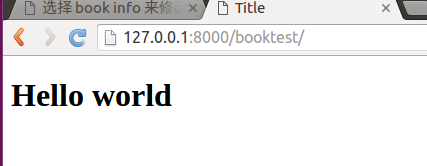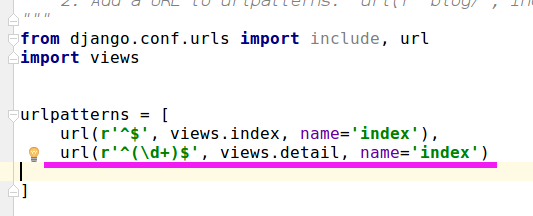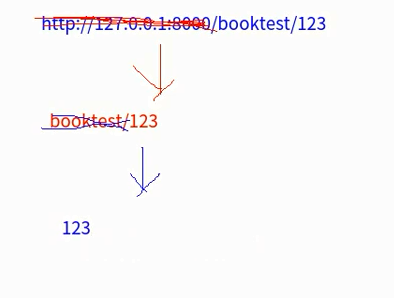3 View视图 URLconf
1.视图
- 视图接受Web请求并且返回Web响应
- 视图就是一个python函数,被定义在views.py中
- 响应可以是一张网页的HTML内容,一个重定向,一个404错误等等
- 响应处理过程如下图:




2 准备工作 搭建test3
python@ubuntu:~$ workon h4 (h4) python@ubuntu:~/Desktop/projects$ django-admin startproject test3 (h4) python@ubuntu:~/Desktop/projects/test3$ python manage.py startapp booktest





(h4) python@ubuntu:~/Desktop/projects/test3$ python manage.py runserver
3 URLconf:3种方式
- 在settings.py文件中通过ROOT_URLCONF指定根级url的配置
- urlpatterns是一个url()实例的列表
- 一个url()对象包括:
- 正则表达式
- 视图函数
- 名称name
- 编写URLconf的注意:
- 若要从url中捕获一个值,需要在它周围设置一对圆括号
- 不需要添加一个前导的反斜杠,如应该写作'test/',而不应该写作'/test/'
- 每个正则表达式前面的r表示字符串不转义
(1)请求的url被看做是一个普通的python字符串,进行匹配时不包括get或post请求的参数及域名
http://www.itcast.cn/python/1/?i=1&p=new,只匹配“/python/1/”部分


(2)正则表达式非命名组,通过位置参数传递给视图
url(r'^([0-9]+)/$', views.detail, name='detail'),







(3) 正则表达式命名组,通过关键字参数(Parameter)传递给视图,本例中关键字参数为id
url(r'^(?P<id>[0-9]+)/$', views.detail, name='detail'),



- 参数匹配规则:优先使用命名参数,如果没有命名参数则使用位置参数
- 每个捕获的参数都作为一个普通的python字符串传递给视图
- 性能:urlpatterns中的每个正则表达式在第一次访问它们时被编译,这使得系统相当快
4.包含其它的URLconfs
- 在应用中创建urls.py文件,定义本应用中的urlconf,再在项目的settings中使用include()
from django.conf.urls import include, url urlpatterns = [ url(r'^', include('booktest.urls', namespace='booktest')), ]
- 匹配过程:先与主URLconf匹配,成功后再用剩余的部分与应用中的URLconf匹配
请求http://www.itcast.cn/booktest/1/ 在sesstings.py中的配置: url(r'^booktest/', include('booktest.urls', namespace='booktest')), 在booktest应用urls.py中的配置 url(r'^([0-9]+)/$', views.detail, name='detail'), 匹配部分是:/booktest/1/ 匹配过程:在settings.py中与“booktest/”成功,再用“1/”与booktest应用的urls匹配
- 使用include可以去除urlconf的冗余
- 参数:视图会收到来自父URLconf、当前URLconf捕获的所有参数
- 在include中通过namespace定义命名空间,用于反解析
5 URL的反向解析
- 如果在视图、模板中使用硬编码的链接,在urlconf发生改变时,维护是一件非常麻烦的事情
- 解决:在做链接时,通过指向urlconf的名称,动态生成链接地址
- 视图:使用django.core.urlresolvers.reverse()函数
- 模板:使用url模板标签



